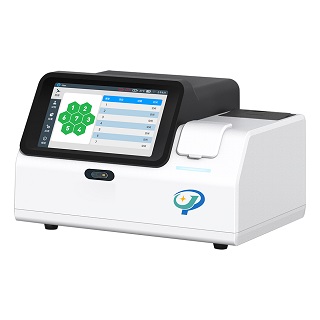What is Glycated Hemoglobin (HbA1c) test?
Poclight: Glycated Hemoglobin Detection Solution
1. What is Glycated Hemoglobin?
Recent data shows that there are currently about 114 million diabetes patients and 500 million people in prediabetes in China. According to the Chinese Type 2 Diabetes Prevention and Treatment Guidelines (2020 edition), in type 2 diabetes, diagnosis also requires testing of patients' random blood glucose (RPG), fasting blood glucose (FPG), 2-hour glucose tolerance test (OGTT 2h), and glycated hemoglobin (HbA1c). Glycated hemoglobin, composed of HbA1a, HbA1b, and HbA1c, of which HbA1c accounts for about 70%, is structurally stable. Unlike direct glucose level testing with OGTT and FPG, HbA1c is a non-enzymatic reaction product formed slowly by the combination of glucose and hemoglobin, reflecting the average blood glucose level over the past 2-3 months.
2. Testing Techniques and Methods for Glycation
Currently, glycated hemoglobin detection methods used in clinical practice mainly fall into two categories based on principles: those based on charge changes (physical methods) and those based on structural differences (chemical methods). The most used HbA1c detection methods on the market are immunoassay and high-performance liquid chromatography (HPLC). HPLC is currently the internationally recognized standard method, but it is limited by factors such as expensive instrument prices, high maintenance costs, significant impact of column efficiency on test results, and interference from variants and hemoglobin derivatives (such as glycated hemoglobin, acetylated hemoglobin, HbF) during co-elution, which have hindered its widespread application to some extent. Immunoassay, using HbA1c as an antigen, is based on the principle of antigen-antibody recognition and typically targets 4-8 amino acid residues at the N-terminus of the glycated hemoglobin beta chain as antibody recognition sites, detecting the "true" HbA1c defined by the IFCC reference system, mainly divided into immuno-turbidimetry, immuno-agglutination, chemiluminescence, etc. In 2013, the College of American Pathologists (CAP) survey found that 67% of HbA1c laboratories used this method, which has now become the mainstream detection method.
Methodology | Principle | Advantages | Disadvantages |
Immuno-turbidimetry | Using immuno-turbidimetry, total hemoglobin is detected through the hemolysin colorimetric method, and the percentage content of HbA1c is calculated. | Easy to operate, fast detection speed, low cost, good repeatability, high recovery, CV<2% | Poor ability to resist cross-contamination, small linear range, susceptible to interference from HbF and abnormal hemoglobin, poor result stability |
Immuno-agglutination method | The immuno-agglutination method utilizes latex particles sensitized with anti-HbA antibodies to bind with corresponding antigens, thereby inducing an agglutination reaction. The degree of agglutination is measured by determining absorbance, directly indicating the percentage content of HbA1c in total Hb | Fast detection speed (within 7 mins), strong specificity, effectively avoids interference from variant hemoglobins. | Complex operation, susceptible to interference, poor ability to resist cross-contamination, lower precision, with a coefficient of variation (CV) typically exceeding 6%. |
Chemiluminescence | The ion-capture immunoassay method utilizes the principle of antigen-antibody reaction, coupled with fluorescent labeling. This involves linking fluorescent markers to negatively charged polyionic complexes, which are then adsorbed onto positively charged fiber surfaces. After a series of thorough washing steps, the change in fluorescence intensity is measured to calculate the concentration. | Easy to standardize and repeat, high detection sensitivity and specificity, high recovery rate and accuracy, low cross-contamination rate, few influencing factors. | Need to purchase CLIA analyzer, which is costly and suitable for high-volume sample testing. |
3. Poclight Biotech: Fifth-Generation Chemiluminescent Solution for Glycation Detection
Poclight Biotech, founded in 2019, is dedicated to the field of rapid testing with "extremely simple and fast homogeneous chemiluminescence", relying on the " Chemiluminescence Resonance Energy Transfer (CRET)" platform to develop fifth-generation chemiluminescent products, solving many problems existing in the most advanced magnetic particle chemiluminescence in the field of immune detection, filling the domestic blank.
① Poclight : Mini CLIA C5000 Device

The C5000 semi-automatic dry CLIA analyzer is used for testing. It is fully automated process from sample to results. The operation process is more simplified, and multiple projects can be run simultaneously on the machine, reducing the likelihood of errors. At the same time, the C5000 semi-automatic dry CLIA analyzer adopts CRET technology, with a compact body, easy to move, high flexibility, and versatile specimen types including whole blood, plasma, serum, urine, hair, etc. The reagent projects cover inflammation, myocardium, thyroid function, sex hormones, hypertension, sugar metabolism, bone metabolism, etc., with various testing modes including random, batch, and emergency.
② Poclight Reagents
The world's first freeze-dried bead immunoassay reagent has advantages such as high precision, low cost, fast speed, and convenient transportation, solving the pain points of traditional chemiluminescent assay reagents requiring cold chain transportation and refrigeration storage, with a short shelf life. Poclight’s dry CLIA glycated HbA1c products have successfully obtained registration approval. The reagents can be stably stored at room temperature without requiring cold chain refrigeration and adopt single-serving packaging design. Poclight’s glycated projects feature: only 5µL of glycated detection required, supporting peripheral blood testing.
Summary
Using fifth-generation single-serving chemiluminescence technology to detect glycated hemoglobin, the instrument has no complex fluidics, no additional maintenance costs, and achieves on-demand testing. This testing method aims to reduce testing costs, improve efficiency, and ensure the accuracy and reliability of clinical data, making it a wise choice for glycated hemoglobin detection.
评论
发表评论